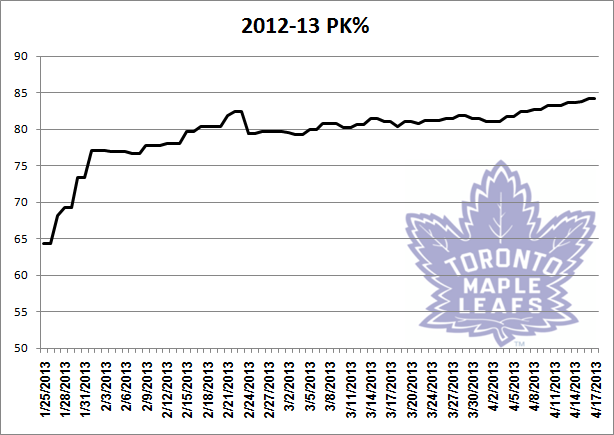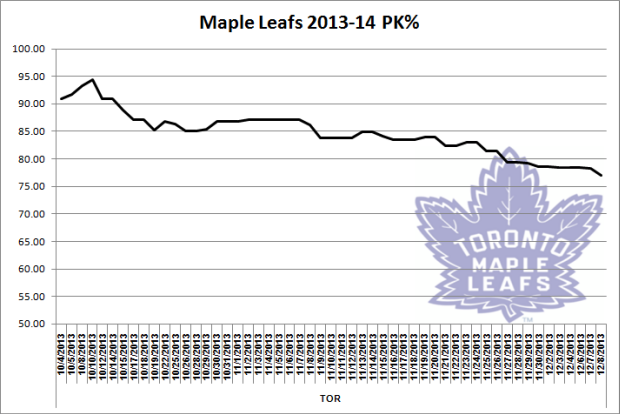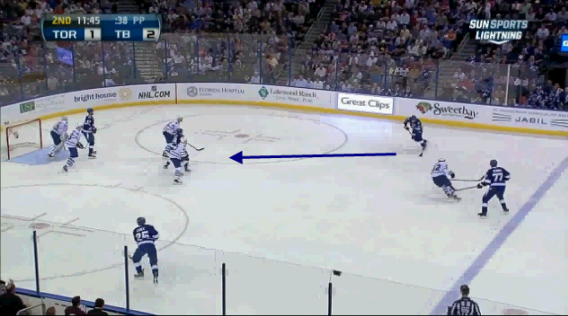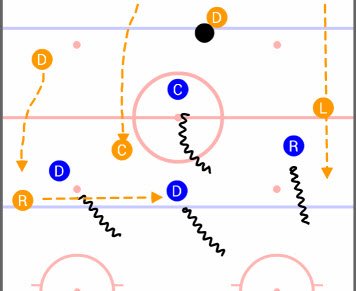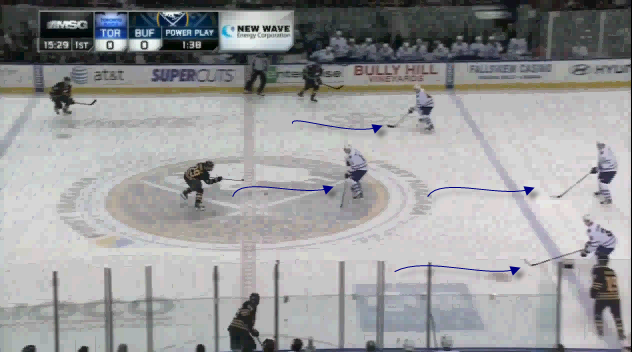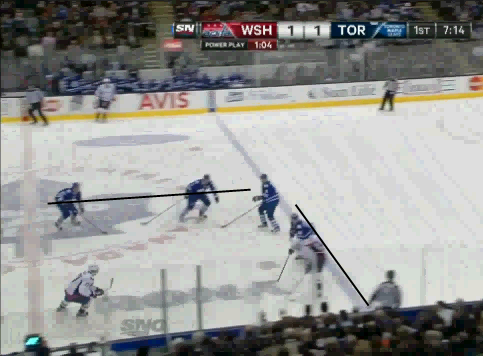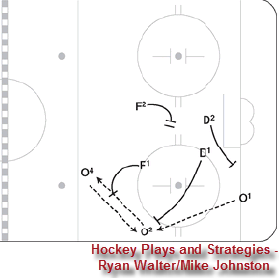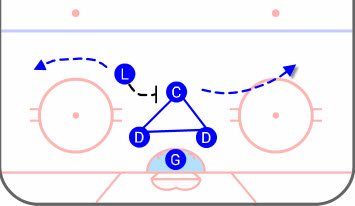There isn’t much I can add to the powerplay analysis that wasn’t in the write up by JP Nikota describing the Leafs use of the 1-3-1. They adopted this system in 2012-13 while more teams have incorporated the formation throughout the NHL.
This may be the same reason Randy Carlyle has kept the penalty killing system intact for the last two seasons.
More relevant in 2013-14 is the severe drop off in the success of killing penalties, a part of the ’12-13 Leafs that excelled while sitting at the top of the standings and helping propel the Buds into their first playoffs appearance of the post-lockout era.
The drop off is indeed staggering and lacking any systematic explanation.
The trend is getting ugly here.
After analyzing a tonne of video in an effort to identify differences between seasons, it’s time for the Occam’s Razor approach, with the likeliest culprit being the sheer increase in the amount of penalties amassed and outlined by Cam Charron over at Leafs Nation. Taking more penalties is indicative of underlying possession issues, of not having the puck and picking up a penalty to try to regain possession.
There’s a warning sign right there about the effect of not having the puck for long periods at even strength, 5v5 or 4v4. Lack of discipline may not be the main cause; the lack of puck possession is more likely to generate an increase in minor penalties.
Before getting into the analysis of the overall system, let’s look at some games from ’12-13. The focus is on two items here: the zone entry and the Leafs passive formation, and the forward’s interaction/interchangeable nature when the Sabres set up.
Each forward covers up in the middle/slot while the other engages the puck carrier at the point and on the side boards.
Against the Washington Capitals here, the focus is on zone entry and the difficulty the Caps have getting into the zone. Some of that is the penalty killing forecheck in the neutral zone, and some ineptitude of the Capitals breakout rushing the puck up ice.
Toronto lines up three players along the blueline with a roaming forechecker attempting to disrupt the breakout. Also worth noting here is also an aggressive approach in the neutral zone, making entry into the zone very difficult. Forcing the opposition to bobble the puck on entry or making entry itself difficult has obvious positives in killing the clock.
Boston has struggled with the man-advantage, but the focus is on the slot man here on setup and how he’s able to break away from the penalty killer at the top of the pyramid in the slot for an extra chance in close. Jay McClement is locked on to the shooter at the point while the Bruins slot man drops to the top of the crease for an attempt.
With the abundance of scoring talent to put out as a powerplay unit, Tampa Bay also moves back to an overload on their second unit. An overload formation is when the defensemen line up at the top of the zone and three forwards form a triangle on the one side of the ice, as seen here via the Blue Seat Blogs. It’s easy for teams to set up into the 1-3-1 by dropping the one defenseman to the half boards. Most teams have used the overload and are now switching that up to the 1-3-1 or a variation of that formation.
Even Toronto reverts to an overload when they are retrieving loose pucks on the powerplay; that is, dropping the player back to the point while the three forwards fight to regain possession of the puck and once again set up the 1-3-1.
Below, around the one minute mark, the Lightning demonstrate creating separation by drawing out the roaming forward before a quick pass off. Tyler Bozak is drawn out really high before the pass is sent down to the right side, where the winger is able to step into a shot on goal.
Here’s the video sequence.
PENALTY KILLING SYSTEM – Czech Press
Here’s how the Leafs (and Marlies) approach penalty killing. Let’s start with the zone entry.
The best description of the system stems from the great resource Hockey Plays and Strategies by Ryan Walter and Mike Johnston, who named it the ‘Czech Press.’
The forward locks up the right wing with a rover up front. Both teams seem to be retreating into the zone and aren’t aggressively forechecking as much, ensuring there’s coverage in case they take the blueline while forcing the powerplay team to dump the puck behind them or skate it up the sides and in.
This is the look from 2012-13 with the formation staying consistent in 2013-14.
If there’s one noticeable difference between seasons, it’s the reduced tendency of roaming for the lead penalty killing forward. The effect was more noticeable in ’12-13, when the forward would lead and engage the puck carrier. In ’13-14, the forward stays firm in formation.
A retreating box works best against teams that like to dump the puck into the zone due to the space afforded by the defensemen at the line. In general, it will allow a greater amount of zone entries, limit the middle of the ice, push opponents to the side, and limit cross-ice passes.
There’s a moment in the video against the Capitals where they try to isolate the puck carrier similar to a closing of a pincer when the Capitals forwards bobble the zone entry.
When a team does finally get into the zone and sets up with the new sexy 1-3-1 formation as described above, the Leafs‘ counter is to ensure there is always a man in the middle of the ice with an active stick. Once any forward abandons that spot to engage somewhere else in the zone, the other forward immediately occupies that space.
It looks like this below, where the puck is passed across to the point and the center occupies the slot the winger has vacated. Having a man in that spot always takes away the direct point shot, especially if the forward takes away the point very quick.
If at all possible, the goal is to regain possession and clear the zone, whether by a clearing event or skating it out into center ice before dumping it the length of the ice.
Placing an imaginary triangle – from the slot forward to the defensemen, with the other forward engaging on the strong side – illustrates how the set up and mechanics operate.
A variety of rules apply when down a man; common sense items like having an active stick, outworking the powerplay units and getting off for a line change at every opportunity, while maintaining awareness of their surroundings.
This one, however, is a must.
Let’s see how all of this has been executed in 2013-14.
This first video is of the second game of the season against the Philadelphia Flyers, where the Leafs allowed one goal in seven powerplay opportunities. There are four different forward pairings [James Van Riemsdyk, Dave Bolland (and Bolland with Nik Kulemin) – Tyler Bozak, Jay McClement – Mason Raymond, Troy Bodie] in the sequences and they each play the slot as diagramed above.
The late November game against the Washington Capitals was interesting to note because of the ‘shadow’ Randy Carlyle placed to neutralize the presence of Alexander Ovechkin, changing the dynamic of the penalty kill from a 5v4 to a makeshift 4v3 with the puck and formation out of whack. The Leafs forwards break away from the traditional replacement of space in the slot and have a stationary forward patrolling that lone area. Having the flexibility to change things up adds a dynamic that can’t be spotted easily by advanced scouting and would require in-game adjustments by opposition coaching staffs.
A few nights later, the Pittsburgh Penguins used three powerplay goals to creep back into the game after the Leafs ran up a 4-1 score. Yes, yes, there were third period shenanigans that contributed to the contest; however, the penalty kill let them down.
The slot man formation is just as evident here.
These are the Pittsburgh powerplay goals in that game; two while playing 5v4 and the third on a two-man advantage with a bullet of a shot.
A systematic explanation of the Leafs penalty killing isn’t fully available to explain the dramatic drop off. There isn’t enough of a systematic change from what made the units successful in ’12-13.
The bigger issue stems from the problem plaguing Toronto in general, their play at even strength leading to a significantly higher amount of penalties,
The powerplay and penalty killing units aren’t a weak spot here. The causes are much greater than any systematic breakdown.
To start figuring out where, it’s important to look at what is happening in the complete game.
Issues that need to be address begin in the defensive zone and continue in the approach to the offensive and neutral zone forecheck.
****************************************
Thanks for following along in this systems series.






















